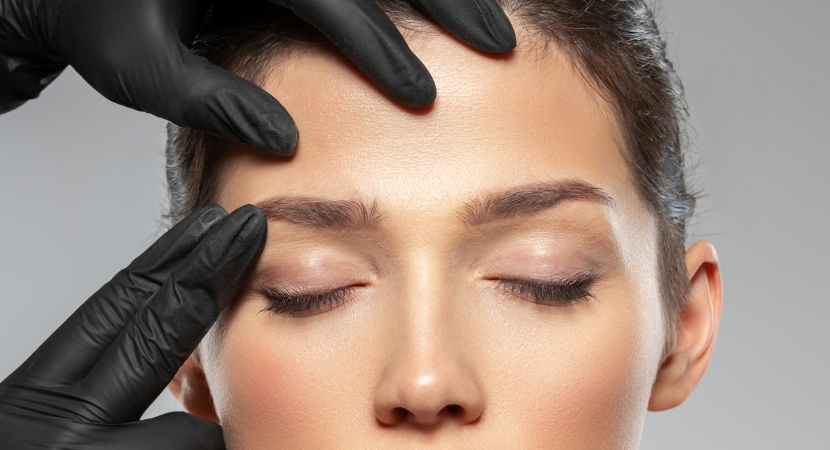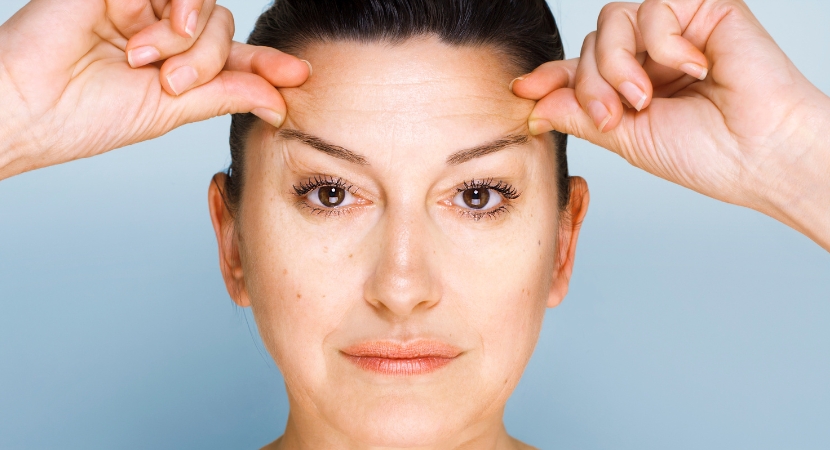
The effects of aging are inevitable, and the forehead often exhibits the earliest symptoms. The skin's elasticity begins to deteriorate. Sun exposure, wind, and gravity influence the face, causing frown lines, wrinkles on the forehead, and a drooping of the eyebrows.
Even people in their thirties may have an appearance that looks much older than their years. Others may misinterpret your appearance as tired, angry, or depressed when it's not the case. As a result, many people opt for a brow lift procedure. Various methods are used to perform this surgery depending on the age of men and women and advancements in medical technologies.
A forehead lift is a plastic surgery procedure used to alleviate sagging of the skin on the forehead, eyebrows, and upper eyelids. It can also help reduce the appearance of wrinkles on the forehead and between the eyes.
Surgical brow lift, also known as forehead lift, browplasty, or temporal lift, is a cosmetic procedure. The surgery addresses the wrinkles on the forehead, including horizontal lines across the forehead and on the bridge of your nose.
Why Forehead Wrinkles?
Wrinkles are a common and normal sign of aging, caused by both natural factors and various environmental elements, some of which you may be able to control. Common causes of forehead wrinkles include:
1. Aging: It's not surprising that wrinkles on the forehead and other signs of skin aging become more common as you age. The skin produces less collagen, an essential structural protein found in connective tissue, over time. Studies show that collagen levels in the skin decrease by about one percent each year.
2. Sun Exposure: Spending time in the sun without protection can expose your skin to UV radiation, a primary cause of premature aging. Excessive sun exposure also increases the risk of developing skin cancer.
3. Smoking: Tobacco smoking is linked to a decrease in collagen synthesis, with research indicating that smokers produce certain types of collagen at a slower rate than non-smokers.
4. Genetics: Similar to other aspects of your external appearance, your genetics may play a role in the likelihood of developing forehead wrinkles.
Other factors that can contribute to the appearance of forehead wrinkles include alcohol consumption, poor sleep habits, and excessive use of facial muscles. For example, facial expressions like smiling, raising eyebrows, and squinting require the use of facial muscles. Over time, these expressions can lead to the development of channels in your skin, ultimately turning into wrinkles. Contrary to common perception, wrinkles do not suddenly appear in your skin when you enter your 30s, 40s, 50s, or 60s. Instead, wrinkles typically develop slowly over time, becoming visible only when they are deep and pronounced enough to notice. If you are concerned about wrinkles, it's essential to pay attention to your skin. Look for signs of wrinkles on the forehead and other areas of your face.

Why is it performed?
This technique is most commonly performed on individuals in their 40s to 60s to alleviate the signs of aging. It can also help people with hereditary conditions such as furrowed lines above the nose or drooping eyebrows. Forehead lifting can elevate low eyebrows in younger individuals, giving the face a "sad" appearance. The surgery can also be performed on individuals whose eyebrows are so low that they obstruct the upper part of their visual field.
A good candidate for forehead lifting has one or more of the following:
• Deep furrows between the eyes.
• Horizontal wrinkles on the forehead.
• A nose that does not function properly.
• Drooping eyebrows.
• Tissue hanging down towards the outer part of the eyelids.
Goals of Forehead Lift
Forehead lift, also known as brow lift, aims to:
• Reduce wrinkles that develop horizontally across the forehead, as well as those that appear on the bridge of the nose between the eyes.
• Improve frown lines, the vertical folds that develop between the eyebrows.
• Lift drooping eyebrows, which can hood the upper eyelids.
• Position the eyebrows in an alert and youthful position.
Other cosmetic procedures that can be performed with a forehead lift include:
• Upper and/or lower eyelid surgery (blepharoplasty).
• Facelift.
• Skin resurfacing techniques.
Who is a Candidate?
You may be a candidate for a forehead lift if you:
• Are physically healthy.
• Are a non-smoker.
• Have a positive outlook and realistic goals.
Unwanted wrinkles on the forehead can emerge with age. Furrowed lines between the eyebrows can give the appearance of anger or seriousness. Skin laxity can cause the eyebrows to sag, hooding the upper eyelids and creating a tired look. If these signs of aging in the forehead area concern you, a forehead lift may be right for you.

Contraindications
Poor medical health, such as poorly controlled diabetes, hypertension, uncompensated heart or lung diseases, individuals regularly taking blood-thinning medications, patients with unrealistic expectations, and heavy smokers are considered relative contraindications. Fine wrinkles that can be effectively managed through non-surgical or conservative therapies are contraindications for a facelift surgery. Secondary facelifts should also be approached with caution, as scarring from previous treatments may alter the initial tissue planes, increasing the risk of facial nerve injury.
Forehead Lift Cost
According to the 2020 statistics from the American Society of Plastic Surgeons, the average cost of a forehead lift is $3,900. This average cost is just a part of the overall expenses; anesthesia, operating room, and other associated fees are not included. To determine your total fee, please consult with the cosmetic surgeon's office.
The pricing for a forehead lift surgery will be determined by the surgeon's experience, the type of technique performed, and the geographical location of the practice.
Before the Procedure
You will have a consultation before the procedure. Anamnesis, a physical examination, and a psychiatric assessment will be conducted. You may want to bring someone with you (like your spouse) to the appointment. Please feel free to ask questions. Make sure you understand the answers to your queries. You should fully comprehend the preoperative actions, the procedure itself, and the postoperative care. A week before the surgery, you may be asked to stop taking blood thinners. These medications can lead to increased bleeding during the operation.
• Some of these medications include aspirin, ibuprofen (Advil, Motrin), and naproxen (Aleve, Naprosyn).
• If you are taking warfarin (Coumadin, Jantoven), dabigatran (Pradaxa), apixaban (Eliquis), rivaroxaban (Xarelto), or clopidogrel (Plavix), talk to your surgeon before stopping or changing the way you take these medications.
In the days before the surgery:
• Ask which medications you still need to take on the day of the surgery.
• Always inform your healthcare provider if you have a cold, flu, fever, herpes, or any other illness in the days leading up to the surgery.
On the day of the surgery:
• On the night before the surgery, you will likely be instructed not to drink or eat anything after midnight. Chewing gum and breath mints are examples of such items. If your mouth feels dry, rinse it with water. Be careful not to swallow.
• Take your prescribed medications with a small sip of water.
• Arrive on time for the procedure.
• Follow any additional advice provided by your surgeon.

Various Methods of the Procedure
Your doctor may use one of the following techniques:
1. Endoscopic Brow Lift: Several small incisions will be made behind your hairline by your surgeon. Then, he or she will insert an endoscope (a long, thin tube with a light and a small camera at one end) into one of the incisions to examine the underlying muscles and tissues. Your surgeon will lift the tissues of the forehead and secure them in place with stitches, small screws, or another approach, using a surgical device inserted through another incision. Stitches or small clips are used to close the incisions.
2. Classic or Coronal Brow Lift: Your surgeon will make an incision behind the hairline across the top of the head, from ear to ear or mainly at the top of your head. He or she will lift your forehead to its new position, with the scalp in front of the incision overlapping the scalp behind it. Then, the overlapping scalp is removed, and the remaining scalp is stitched together. This technique is usually not done in people with high hairlines, thin hair, or those prone to hair loss.
3. Pre-Hairline Brow Lift: Between the upper part of the forehead and the beginning of the hairline, your surgeon will make an incision. Instead of removing scalp, he or she will take a small amount of skin and tissue from the top of your forehead. As a result, your hairline will not be pulled back. If you have a high receding hairline, you may benefit from a pre-hairline brow lift. However, depending on how well the wound heals, a scar may appear along the hairline.

Forehead Lift Procedure
The muscles and skin that contribute to sagging eyebrows, hooded eyelids, forehead furrows, and frown lines are removed or altered during a forehead lift. The procedure can be performed on its own or in conjunction with other surgeries such as a facelift, eyelid surgery, or nose reshaping. The surgeon's office, an outpatient surgical facility, or a hospital can perform the procedure. It is typically done as an outpatient procedure without an overnight stay.
You will be awake, but a local anesthetic will be used to numb the area and prevent pain. Medications may be given to help you relax. In some circumstances, general anesthesia may be used. You may experience some pain and tension in the skin of the forehead during the process.
During the surgery:
• Hair will be secured away from the surgical area. Hair in front of the incision line may need to be trimmed, but large portions of hair will not be shaved.
• The surgeon will make a surgical incision (cut) at the level of the ears. This incision will extend above the forehead at the hairline to avoid making the forehead appear excessively high.
• If you are bald or balding, the surgeon may make an incision at the center of your head to avoid noticeable scarring.
• Some surgeons will use multiple small incisions and an endoscope (a long, thin instrument with a small camera at the end) to complete the procedure. Dissolvable implants may be used to secure the lifted skin.
• The surgeon will seal the incision with stitches or staples after removing excess tissue, skin, and muscles. Your hair and face will be washed before applying dressings to prevent irritation of the scalp skin.
What to Expect After the Surgery
In the 10-day period following the surgery, you can expect swelling and bruising. This condition may affect the cheeks, eyes, and forehead in some individuals. To reduce swelling, you will be advised to keep your head elevated. Cold compresses can help minimize swelling even further. As the incisions heal, you may experience numbness and itching, both of which should subside over time. The stitches are typically removed 7-10 days after the surgery.
To avoid swelling, keep your head elevated for 2 to 3 days after the operation. Bruising and swelling around the eyes and cheeks will develop but should subside within a few days or weeks.
The numbness on the forehead and scalp will be replaced by itching or tingling as the nerves recover. It may take up to 6 months for these sensations to completely disappear.
Dressings are removed after 1-3 days. It is crucial to follow your surgeon's recommendations for resuming normal activities. Most patients should recover within two weeks or less, although they should avoid vigorous activity for extended periods. Any visible bruising can be concealed with regular makeup procedures.
Forehead lifting is often combined with blepharoplasty (eyelid surgery) or facelift to achieve a more harmonious rejuvenation. Many facial defects and signs of premature aging that can impact confidence can be corrected with facial plastic surgery. Cosmetic surgery can make you feel better about yourself by changing your external appearance.

How Long Does Forehead Lifting Last?
Forehead lifting is semi-permanent, as wrinkles may return over time, but they will never be as wide and deep as before the surgery.
It's important to note that forehead lifting does not address sagging eyelids. This requires a different procedure called blepharoplasty, but both can be performed simultaneously. Discuss with your surgeon the possibility of undergoing multiple procedures at once.
Risks
Forehead lifting carries various risks, including:
1. Scarring: Scars may be visible after forehead lifting.
2. Changes in Skin Sensation: Forehead lifting may cause temporary or permanent numbness in the forehead or the upper part of the scalp.
3. Asymmetry in Brow Position: Forehead lifting may lead to asymmetry, with one or both eyebrows appearing too high. However, asymmetry may be corrected during the healing process. Persistent issues with brow shape or position can be treated with additional surgery.
4. Hair Issues: Forehead lifting may result in an elevated hairline or hair loss at the incision site. If hair loss doesn't resolve on its own, it can be treated with scar excision or hair grafting.
Like any major surgery, forehead lifting poses risks of bleeding, infection, and adverse reactions to anesthesia.
Postoperative Expectations
In the 10-day period following the surgery, you will be able to walk around but won't be able to work for at least 7 days. You can use shampoo and shower 4 days after the operation.
Within 10 days, you should be able to return to work. You'll need to limit vigorous physical activities (jogging, bending, heavy household chores, sex, or any activity that increases your blood pressure) for a few weeks. Avoid contact sports for 6 to 8 weeks. Limit exposure to heat or sun for several months.
Your hair may be slightly thinner around the incision for a few weeks or months, but it should start growing normally again. Hair won't grow along the actual scar line. Wearing your hair down on your forehead will hide most scars.
Most signs of the surgery should fade completely within 2 to 3 months. Makeup can conceal minor swelling and bruising. Initially, you may feel tired and disappointed, but this will pass as you begin to look and feel better.
Most people are satisfied with the results of forehead lifting. They appear much younger and more rested than before. The procedure reduces the outward signs of aging for years. Even if the surgery isn't repeated in later years, you will likely look better than if you had never had a forehead lift.
Conclusion
If time and gravity have changed your forehead, making you look serious, angry, or tired, you may consider forehead lifting. Surgical brow lifting is a cosmetic procedure that repositions your forehead to correct wrinkles, frown lines, and sagging brows. While wrinkles may return over time, they will never be as wide and deep as before the surgery.
The aging process causes the skin and muscles of the face to sag. Forehead lifting can benefit patients with drooping brows causing hooded upper eyelids, forehead wrinkles, or frown lines between the eyes.
Most people are satisfied with the results of forehead lifting, regardless of the surgical method used. Often, patients don't realize how much their sagging forehead has contributed to signs of aging until they see how much younger and more rested they appear after the lift. While forehead lifting doesn't stop the clock, it can minimize the appearance of aging for years.


